
Economic Outlook, Oakland80 reports unveiled
It was an important day last week for Oakland County as we heard good news in both our annual Economic Outlook forecast, done for the 38th year in a row by the University of Michigan, and we unveiled the inaugural report of our ambitious Oakland80 initiative.
University of Michigan economists Dr. Gabriel Ehrlich and Donald Grimes reported that Oakland County’s economy has a “solidly positive outlook” over the next few years with jobs and wage growth, continued low unemployment and a return to pre-pandemic employment levels by early 2025.
We’re serious about making sure that recovery happens quickly and with gains that will be beneficial for both our residents and our businesses. And I’d like to think that some of our initiatives have helped
soften the economic gut punch brought on by the pandemic. We’ve invested millions of dollars from the federal COVID relief funding through the CARES Act and the American Rescue Plan in innovative initiatives that are helping our residents, businesses and economy not only recover from the pandemic, but thrive and grow.
That’s why the timing of the first Oakland80 report, during the Economic Outlook luncheon, was no coincidence. The work that we’re doing to make sure that 80 percent of our adult population has either a college degree or training certificate by 2030 is the key to ensuring a recovery that is not only successful but sustainable.
The headline I’m so excited to share: Since the Oakland80 initiative began two years ago, we’ve gone from 61% of our residents having a college degree or certified training to 69%.
And I ‘m so proud of our Oakland 80 team who have helped make this happen, as well as our partners in the six Oakland County Michigan Works! offices, the education leaders at schools and colleges and universities, the labor and skilled trades organizations and at the state, where Gov. Gretchen Whitmer shares the goal of getting 60% of Michigan residents a degree or training by 2030. Her continued support for programs like MI Reconnect and Futures for Frontliners are helping us and the state achieve these goals.
Oakland80 puts resources into coaching residents to find their true passions and skills, then helps them get the education and training they need through scholarships and wraparound services, like childcare, transportation, and funding for fees, books, supplies and equipment.
As a result, our residents get the tools to find good jobs that will help support their families and our businesses, who have been telling me for years that they can’t find the workers they need, can fill those jobs with our residents.
While the news is mostly positive, there is still much work to do. Yes, the county overall has a high rate of post-secondary education and training. But this success isn’t consistent for all residents, which is documented in both the Economic Outlook and the Oakland80 reports. Oakland County is one of wealthiest counties in the state and nation, but that economic prosperity is uneven geographically. The area containing Waterford and Pontiac severely lag behind when it comes to household income when compared to other areas like Birmingham, Bloomfield Hills, and Bloomfield Township. We see that same pattern with post-secondary attainment, which is a clear indication that education has a huge impact on income.
Data in the Oakland80 report reveals clear differences in educational attainment for residents along race and ethnic lines as well as in the areas where our residents live. One of my top priorities for Oakland County is to address these disparities. Armed with our five-year strategic framework that charts a path toward a thriving and inclusive economy as one of our key goals, our economic development and Oakland80 teams are working hard to implement strategies to be intentional and deliberate with our work to ensure success for all our residents and businesses. You can read about some of these strategies in the Oakland80 report.
One pretty stark finding from the report: Residents with a college education or training have a median annual wage of $61,796 compared to $25,748 for those without the education or training. That translates into $30 per hour compared to $12 per hour or a $36,000 per year difference.
While I’m happy to celebrate the successes we learned about this week, I also know the work is not done.
|